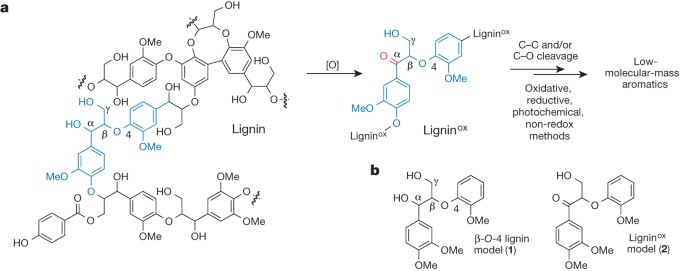
- Select a language for the TTS:
- UK English Female
- UK English Male
- US English Female
- US English Male
- Australian Female
- Australian Male
- Language selected: (auto detect) - EN
Play all audios:
ABSTRACT Lignin is a heterogeneous aromatic biopolymer that accounts for nearly 30% of the organic carbon on Earth1 and is one of the few renewable sources of aromatic chemicals2. As the
most recalcitrant of the three components of lignocellulosic biomass (cellulose, hemicellulose and lignin)3, lignin has been treated as a waste product in the pulp and paper industry, where
it is burned to supply energy and recover pulping chemicals in the operation of paper mills4. Extraction of higher value from lignin is increasingly recognized as being crucial to the
economic viability of integrated biorefineries5,6. Depolymerization is an important starting point for many lignin valorization strategies, because it could generate valuable aromatic
chemicals and/or provide a source of low-molecular-mass feedstocks suitable for downstream processing7. Commercial precedents show that certain types of lignin (lignosulphonates) may be
converted into vanillin and other marketable products8,9, but new technologies are needed to enhance the lignin value chain. The complex, irregular structure of lignin complicates chemical
conversion efforts, and known depolymerization methods typically afford ill-defined products in low yields (that is, less than 10–20wt%)2,10,11. Here we describe a method for the
depolymerization of oxidized lignin under mild conditions in aqueous formic acid that results in more than 60wt% yield of low-molecular-mass aromatics. We present the discovery of this
facile C–O cleavage method, its application to aspen lignin depolymerization, and mechanistic insights into the reaction. The broader implications of these results for lignin conversion and
biomass refining are also considered. Access through your institution Buy or subscribe This is a preview of subscription content, access via your institution ACCESS OPTIONS Access through
your institution Subscribe to this journal Receive 51 print issues and online access $199.00 per year only $3.90 per issue Learn more Buy this article * Purchase on SpringerLink * Instant
access to full article PDF Buy now Prices may be subject to local taxes which are calculated during checkout ADDITIONAL ACCESS OPTIONS: * Log in * Learn about institutional subscriptions *
Read our FAQs * Contact customer support SIMILAR CONTENT BEING VIEWED BY OTHERS OXIDATIVE CLEAVAGE OF C–C BONDS IN LIGNIN Article 23 September 2021 ACCESSING MONOMERS FROM LIGNIN THROUGH
CARBON–CARBON BOND CLEAVAGE Article 04 October 2024 DIRECT CONVERSION OF LIGNIN TO FUNCTIONALIZED DIARYL ETHERS VIA OXIDATIVE CROSS-COUPLING Article Open access 22 May 2023 REFERENCES *
Ralph, J., Brunow, G. & Boerjan, W. Lignins. _eLS_http://dx.doi.org/10.1002/9780470015902.a0020104 (2007) * Zakzeski, J., Bruijnincx, P. C. A., Jongerius, A. L. & Weckhuysen, B. M.
The catalytic valorization of lignin for the production of renewable chemicals. _Chem. Rev._ 110, 3552–3599 (2010) Article CAS Google Scholar * Sanderson, K. Lignocellulose: a chewy
problem. _Nature_ 474, S12–S14 (2011) Article CAS Google Scholar * Lin, S. Y. & Lin, I. S. in _Ullmann’s Encyclopedia of Industrial Chemistry_ 5th edn (eds Elvers, B., Hawkins, S.,
Schulz, G. ) Vol. A15 305–315 (VCH, 1985) Google Scholar * Tuck, C. O., Pérez, E., Horváth, I. T., Sheldon, R. A. & Poliakoff, M. Valorization of biomass: deriving more value from
waste. _Science_ 337, 695–699 (2012) Article CAS ADS Google Scholar * Holladay, J. E., Bozell, J. J., White, J. F. & Johnson, D. _Top Value-added Chemicals from Biomass_ Vol. 2
http://www1.eere.energy.gov/bioenergy/pdfs/pnnl-16983.pdf (United States Department of Energy, 2007) Google Scholar * Ragauskas, A. J. et al. Lignin valorization: improving lignin
processing in the biorefinery. _Science_ 344, 1246843 (2014) Article Google Scholar * Hocking, M. B. Vanillin: synthetic flavoring from spent sulfite liquor. _J. Chem. Educ._ 74, 1055–1059
(1997) Article CAS Google Scholar * Business Areas. _Borregaard_ http://www.borregaard.com/Business-Areas (20 June 2014) * Pandey, M. P. & Kim, C. S. Lignin depolymerization and
conversion: a review of thermochemical methods. _Chem. Eng. Technol._ 34, 29–41 (2011) Article CAS Google Scholar * Wang, H., Tucker, M. & Ji, Y. Recent development in chemical
depolymerization of lignin: a review. _J. Appl. Chem_ 2013, 1–9 (2013) Article Google Scholar * Gierer, J. & Norén, I. Oxidative pretreatment of pine wood to facilitate delignification
during kraft pulping. _Holzforschung_ 36, 123–130 (1982) Article CAS Google Scholar * Ljunggren, S. & Olsson, A. The specificity in oxidation of some lignin and carbohydrate models
and pine wood shavings with permanganate and pyridinum dichloromate before the kraft pulping process. _Holzforschung_ 38, 91–99 (1984) Article CAS Google Scholar * Rahimi, A., Azarpira,
A., Kim, H., Ralph, J. & Stahl, S. S. Chemoselective metal-free aerobic oxidation in lignin. _J. Am. Chem. Soc._ 135, 6415–6418 (2013) Article CAS Google Scholar * Crestini, C. &
D’Auria, M. Singlet oxygen in the photodegradation of lignin models. _Tetrahedron_ 53, 7877–7888 (1997) Article CAS Google Scholar * Fukagawa, N. & Ishizu, A. Photoreaction of
phenacyl aryl ether type lignols. _J. Wood Chem. Technol._ 11, 263–289 (1991) Article CAS Google Scholar * Argyropoulos, D. S. & Sun, Y. Photochemically induced solid-state
degradation, condensation, and rearrangement reactions in lignin model compounds and milled wood lignin. _Photochem. Photobiol._ 64, 510–517 (1996) Article CAS Google Scholar * Vanucci,
C., De Violet, P. F., Bouas-Laurent, H. & Castellan, A. Photodegradation of lignin: a photophysical and photochemical study of a non-phenolic α-carbonyl β-O-4 lignin model dimer,
3,4-dimethoxy-α-(2′-methoxyphenoxy) acetophenone. _J. Photochem. Photobiol. Chem._ 41, 251–265 (1988) Article CAS Google Scholar * Nguyen, J. D., Matsuura, B. S. & Stephenson, C. R.
J. A photochemical strategy for lignin degradation at room temperature. _J. Am. Chem. Soc._ 136, 1218–1221 (2014) Article CAS Google Scholar * Collinson, S. R. & Thielemans, W. The
catalytic oxidation of biomass to new materials focusing on starch, cellulose and lignin. _Coord. Chem. Rev._ 254, 1854–1870 (2010) Article CAS Google Scholar * Chatel, G. & Rogers,
R. D. Oxidation of lignin using ionic liquids—an innovative strategy to produce renewable chemicals. _ACS Sustainable Chem. Eng._ 2, 322–339 (2014) Article CAS Google Scholar * Chang, H.,
Cowling, E. B. & Brown, W. Comparative studies on cellulolytic enzyme lignin and milled wood lignin of sweetgum and spruce. _Holzforschung_ 29, 153–159 (1975) Article CAS Google
Scholar * Ralph, J. & Landucci, L. L. in _Lignin and Lignans; Advances in Chemistry_ (eds Heitner, C., Dimmel, D. R. & Schmidt, J. A. ) 137–234 (CRC Press, 2010) Book Google
Scholar * Fouad, F. M. & Farrell, P. G. Primary and secondary kinetic isotope effects in E2 elimination reactions. _Tetrahedr. Lett._ 19, 4735–4738 (1978) Article Google Scholar * Xu,
W., Miller, S. J., Agrawal, P. K. & Jones, C. W. Depolymerization and hydrodeoxygenation of switchgrass lignin with formic acid. _ChemSusChem_ 5, 667–675 (2012) Article CAS Google
Scholar * Toledano, A. et al. Fractionation of organosolv lignin from olive tree clippings and its valorization to simple phenolic compounds. _ChemSusChem_ 6, 529–536 (2013) Article CAS
Google Scholar * Bauer, K., Garber, D. & Surburg, H. in _Ullmann’s Encyclopedia of Industrial Chemistry_ 5th edn (eds Elvers, B., Rounsaville, J. F. & Schulz, G. ) Vol. A11 199–200
(VCH, 1985) Google Scholar * Bjørsvik, H.-R. & Liguori, L. Organic processes to pharmaceutical chemicals based on fine chemicals from lignosulfonates. _Org. Process Res. Dev._ 6,
279–290 (2002) Article Google Scholar * Martínez, Á. T. et al. Monolignol acylation and lignin structure in some nonwoody plants: a 2D NMR study. _Phytochemistry_ 69, 2831–2843 (2008)
Article Google Scholar * Luterbacher, J. S. et al. Nonenzymatic sugar production from biomass using biomass-derived γ-valerolactone. _Science_ 343, 277–280 (2014) Article CAS ADS Google
Scholar Download references ACKNOWLEDGEMENTS We thank J. Ralph for numerous helpful discussions, H. Kim and A. Azarpira for assistance with the purification and NMR characterization of
aspen lignin, and S. Chakraborty for assistance with gel-permeation chromatographic analysis of lignin samples. Financial support for this project was provided by the Great Lakes Bioenergy
Research Center (Department of Energy Biological and Environmental Research Office of Science DE-FC02-07ER64494). The NMR facility was partly supported by the National Science Foundation
(CHE-9208463) and the National Institutes of Health (S10 RR08389). AUTHOR INFORMATION AUTHORS AND AFFILIATIONS * Department of Chemistry, University of Wisconsin–Madison, 1101 University
Avenue, Madison, 53706, Wisconsin, USA Alireza Rahimi, Arne Ulbrich, Joshua J. Coon & Shannon S. Stahl * Department of Biomolecular Chemistry, University of Wisconsin–Madison, Madison,
53706, Wisconsin, USA Joshua J. Coon Authors * Alireza Rahimi View author publications You can also search for this author inPubMed Google Scholar * Arne Ulbrich View author publications You
can also search for this author inPubMed Google Scholar * Joshua J. Coon View author publications You can also search for this author inPubMed Google Scholar * Shannon S. Stahl View author
publications You can also search for this author inPubMed Google Scholar CONTRIBUTIONS A.R. and S.S.S. conceived the idea for the lignin depolymerisation. A.R. performed the chemical
reactions of lignin and lignin model compounds, including NMR spectroscopic characterization of the products. A.U. and J.J.C. designed the analytical approach to characterize the lignin
depolymerization products. A.U. performed LC/MS analysis. A.R. and S.S.S. wrote the manuscript in consultation with A.U. and J.J.C. CORRESPONDING AUTHOR Correspondence to Shannon S. Stahl.
ETHICS DECLARATIONS COMPETING INTERESTS A patent application based on the results reported here has been submitted. SUPPLEMENTARY INFORMATION SUPPLEMENTARY INFORMATION This file contains
Supplementary Text and Data, Supplementary Figures 1-6 and Supplementary Tables 1-2. (PDF 3606 kb) POWERPOINT SLIDES POWERPOINT SLIDE FOR FIG. 1 POWERPOINT SLIDE FOR FIG. 2 POWERPOINT SLIDE
FOR FIG. 3 POWERPOINT SLIDE FOR FIG. 4 RIGHTS AND PERMISSIONS Reprints and permissions ABOUT THIS ARTICLE CITE THIS ARTICLE Rahimi, A., Ulbrich, A., Coon, J. _et al._ Formic-acid-induced
depolymerization of oxidized lignin to aromatics. _Nature_ 515, 249–252 (2014). https://doi.org/10.1038/nature13867 Download citation * Received: 24 June 2014 * Accepted: 15 September 2014 *
Published: 02 November 2014 * Issue Date: 13 November 2014 * DOI: https://doi.org/10.1038/nature13867 SHARE THIS ARTICLE Anyone you share the following link with will be able to read this
content: Get shareable link Sorry, a shareable link is not currently available for this article. Copy to clipboard Provided by the Springer Nature SharedIt content-sharing initiative


